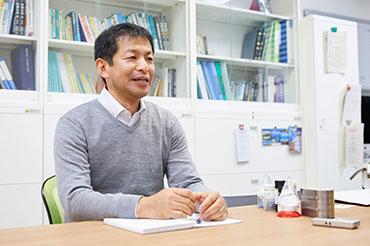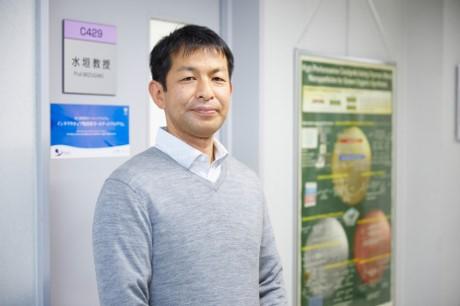Latest Research
The charm of old but new catalysts
PROFESSOR. Tomoo Mizugaki
 Most of the chemical
products around us that support our comfortable lives have been manufactured from raw materials derived from
fossil resources such as petroleum and coal. However, from the perspective of resource and environmental
issues and greenhouse gas reduction, the chemical industry is required to manufacture products that take
Green Chemistry and the 3Rs (Reduce, Reuse, Recycle) into consideration.
Most of the chemical
products around us that support our comfortable lives have been manufactured from raw materials derived from
fossil resources such as petroleum and coal. However, from the perspective of resource and environmental
issues and greenhouse gas reduction, the chemical industry is required to manufacture products that take
Green Chemistry and the 3Rs (Reduce, Reuse, Recycle) into consideration.
The Japanese government has also declared that greenhouse gas emissions will be virtually zero by 2050 toward the realization of a green society. In order to achieve the SDGs (Sustainable Development Goals), it is an urgent task to convert fossil resources to renewable chemical raw materials and to develop resource recycling technology. It is said that catalysts are used in more than 90% of chemical processes, and therefore, catalyst evolution is indispensable for environmentally friendly manufacturing. From now on, it is expected that the fields in which catalysts will play an active role, such as fuel cells and rechargeable batteries, will continue to expand in addition to the effective use of biomass as an alternative resource and hydrogen production.
Thick accumulation is the strength of our laboratory
The history of catalyst research dates back to just under 200 years, but advances in analytical instruments and research methods have made it possible to do new things. We are observing the material at the atomic level under an electron microscope and investigating the structural changes of the catalyst under conditions close to the actual reaction situation using a large radiation facility (Spring-8). Consequently, it has become possible to feed back the results to catalyst development.
A course on catalyst research was established in the School of Engineering Science in 1965, and I am the fifth professor of that course. Currently, our laboratory focuses on solid catalysts in which metal nanoparticles are fixed to inorganic compounds such as clay, but even if nanoparticles are made, the catalytic power may change significantly due to the combination of size and nature. Catalyst research is a mass of know-how. The strength of our laboratory is not only the know-how published in the papers, but also the wisdom accumulated from a huge amount of failure that was not written in the papers, for example, that “this method did not work”.
In the future, I would like to further develop the laboratory’s core technology and expand the research scope to fields such as biomass conversion and carbon dioxide reduction.

Contributing to industry by integrating chemistry “with an on-site feeling comprehension” and different interdisciplinary fields
Since our laboratory belongs to chemical engineering, it is also a laboratory that has an “on-site feeling” in addition to conducting basic research. I often hear from business people and get the feeling that “there seems to be a problem in this part” or “it will work if we can use this”. For example, if a company is looking for what kind of catalyst can be used to make what it wants, there are many ideas that I can advise them, such that they can make it cleaner with this or maybe reduce the amount of precious metal catalysts.
Speaking of recent things, a new collaboration has begun to form little by little as a result of my appearance in a collaborative research laboratory of the School of Engineering Science. It all started when the company side, which hosts a collaborative research laboratory at the School of Engineering Science, told me a relatively vague story about how this material can be used for something. As an expert on investigation of catalytic functions, I joined the collaborative research group, where theoretical researchers and experts in chemical analysis share ideas and cooperate with each other, to advance interesting researches in a way unique to the School of Engineering Science. It is an initiative that has a different aspect from direct collaborative research with a company that usually clarifies the issues, and that we can create something together while sharing ideas with each other.
In the School of Engineering Science, laboratories in various fields, such as chemistry,materials,mechanical,electronics, systems, biology, and information, are can be found in the same building. Since the School was created from the beginning with the aim of integrating different fields, it may help to update my knowledge that this laboratory is doing such a thing just by walking in the corridor. I think that the fact that there is a foundation that does not have to be overwhelmed by “interdisciplinary fusion” here is also valuable in my current catalyst research.
electronics, systems, biology, and information, are can be found in the same building. Since the School was created from the beginning with the aim of integrating different fields, it may help to update my knowledge that this laboratory is doing such a thing just by walking in the corridor. I think that the fact that there is a foundation that does not have to be overwhelmed by “interdisciplinary fusion” here is also valuable in my current catalyst research.
